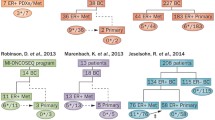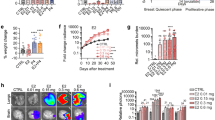Summary
Acquisition of the antiestrogen resistance by breast cancer cellsin vivo may result from a variety of mechanisms. The main pathway appears to involve loss of estrogen receptor (ER) expression or selection for ER negative cells among heterogenous population of tumor cells. However, clinical data suggest that, in about 30% of the cases, antiestrogen resistance arises even in the presence of estrogen receptors. Postulated mechanisms leading to the latter phenotype include selection for variant receptor forms during treatment, development of novel metabolic pathways for the drug, loss of nuclear co-factors, or activation of signal transduction pathway that cross activate ER signals. We have used anin vitro experimental system utilizing LY-2 cell line, an ER positive and antiestrogen resistant MCF-7 cell variant, to study the mechanism of antiestrogen resistance in the presence of functional ER. Result from a complementation experiment suggests that LY-2 phenotype is a recessive trait. Cloning of the genetic defect in the LY-2 cells would provide further insight for the mechanism of antiestrogen resistance in ER positive breast cancer cells.
Similar content being viewed by others
References
Rove RR: Tamoxifen therapy in primary breast cancer: Biology, efficacy, and side effects (review). J Clin Oncol 7: 803–815, 1989
Edwards DP, Murthy SR, McGuire WL: Effects of estrogen and antiestrogen on DNA polymerase in human breast cancer. Cancer Res 40: 1722–1726, 1980
Coezy E, Borgna J-L, Rochefort H; Tamoxifen and metabolites in MCF-7 cells: Correlation between binding to estrogen receptor and inhibition of cell growth. Cancer Res 42: 317–323, 1982
Aitken SC, Lippman ME: Effect of estrogens and antiestrogens on growth-regulatory enzymes in human breast cancer cells in tissue culture. Cancer Res 45: 1611–1620, 1985
Bates SE, Davidson NE, Valverius EM, Dickson RB, Kudlow JE, Freter C, Tam JP, Lippman ME, Salomon DS: Expression of transforming growth factor alpha and its ribonucleic acid in human breast cancer: Its regulation by estrogens and its function. Mol Endocrinol 2: 543–555, 1988
Colletta AA, Wakefield LM, Howell FV, van Roozendaal KEP, Danielpour D, Ebbs SR, Sporn MB, Baum M: Antiestrogens induce the secretion of active transforming growth factor beta from fetal fibroblasts. Br J Cancer 62: 405–409, 1990
Encarnacion CA, Ciocca DR, McGuire WL, Clark GM, Fuqua SAW, Osborne CK: Measurement of steroid hormone receptors in breast cancer patients on tamoxifen. Br Canc Res Treat 26: 237–246, 1993
Fuqua SAW, Fitzgerald SD, Allred DC, Elledge RM, Nawaz Z, McDonnell DP, O'Malley BW, Greene GL, McGuire WL: Inhibition of estrogen receptor action by a naturally occurring variant in human breast tumors. Cancer Res 52: 483, 1992
Fuqua SAW, Fitzerald SD, Chamness GC, Tandon AK, McDonnell DP, Nawaz Z, O'Malley BW, McGuire WL: Variant human breast tumor estrogen receptor with constitutive transcriptional activity. Cancer Res 51: 105, 1991
McGuire WL, Chamness GC, Fuqua SA: Estrogen receptor variants in clinical breast cancer. Mol Endocrinol 5: 1571–1577, 1991
Scott GK, Kushner P, Vigne JL, Benz CC: Truncated forms of DNA-binding estrogen receptors in human breast cancer. J Clin Invest 88: 700, 1991
Karnik PS, Julkarni S, Liu X-P, Budd T, Bukowski RM: Estrogen receptor mutations in tamoxifen-resistant breast cancer. Cancer Res 54: 349–353, 1994
Bronzert DA, Greene GL, Lippman ME: Selection and characterization of a breast cancer cell line resistant to the antiestrogen LY117018. Endocrinology 117: 1409–1417, 1985
Mullick A, Chambon P: Characterization of the estrogen receptor in two antiestrogen-resistant cell lines, LY2 and T47D. Cancer Res 50: 333, 1990
Davidson NE, Bronzert DA, Chambon P, Gelmann EP, Lippman ME: Use of two MCF-7 cell variants to evaluate the growth regulatory potential of estrogen-induced products. Cancer Res 46: 1904–1908, 1986
Knabbe C, Lippman ME, Wakefield LM, Flanders KC, Kasid A, Derynck R, Dickson RB: Evidence that transforming growth factor-beta is a hormonally regulated negative growth factor in human breast cancer cells. Cell 48: 417–428, 1987
Webster MK, Guthrie J, Firestone GL: Glucocorticoid growth suppression response in 13762NF adenocarcinomaderived Con8 rat mammary tumor cells is mediated by dominant trans-acting factors. Cancer Res 51: 6031–6038, 1991
Yoshinaga SK, Peterson CL, Herskowitz I, Yammoto KR: Role of SWI1, SWI2, SWI3 proteins for transcriptional enhancement by steroid receptors. Science 258: 1598–1604, 1993
Khavari PA, Peterson CL, Tamkun JW, Mendel DR, Crabtree GR: BRG1 contains a conserved domain of the SWI2/SNF2 family necessary for normal mitotic growth and transcription. Nature 366: 170–174, 1993
Osborne CK, Wiebe VJ, McGuire WL, Ciocca DR, DeGregorio MW: Tamoxifen and the isomers of 4-hydroxytamoxifen in tamoxifen-resistant tumors from breast cancer patients. J Clin Oncol 10: 304–310, 1992
Osborne CK, Coronado E, Wiebe VJ, DeGregorio M: Acquired tamoxifen resistance correlates with reduced tumor tamoxifen and trans-4-hydroxytamoxifen in human breast cancer. J Natl Cancer Inst 83: 1477–1482, 1991
Pavlik EJ, Nelson K, Srinivasan S, Powell DE, Kenady DE, DePriest PD, Gallion HH, van Nagel JRJ: Resistance to tamoxifen with persisting sensitivity to estrogen: Possible mediation by excessive antiestrogen binding site activity. Cancer Res 52: 4106–4112, 1992
Power RF, Many SK, Codeina J, Conneely OM, O'Malley BW: Dopaminergic and ligand independent activation of steroid hormone receptors. Science 254: 1636–1639, 1991
Author information
Authors and Affiliations
Rights and permissions
About this article
Cite this article
Paik, S., Hartmann, D.P., Dickson, R.B. et al. Antiestrogen resistance in ER positive breast cancer cells. Breast Cancer Res Tr 31, 301–307 (1994). https://doi.org/10.1007/BF00666162
Issue Date:
DOI: https://doi.org/10.1007/BF00666162




